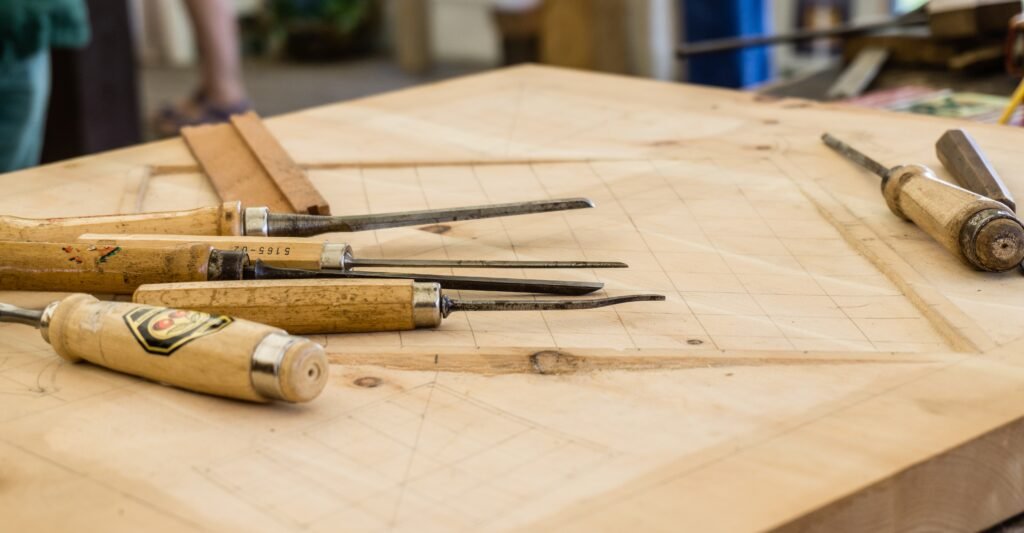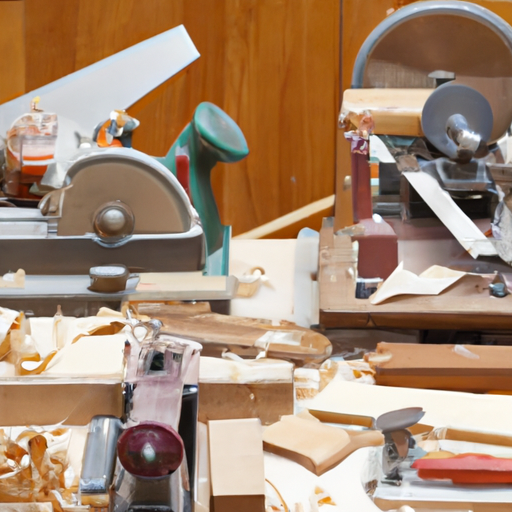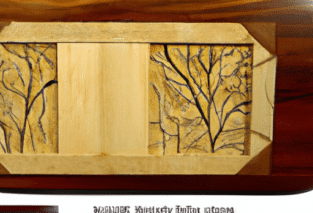In this article, we will explore the various finishing techniques that can enhance the beauty and durability of your woodworking projects. From sanding and staining to applying a protective finish, you will learn step-by-step instructions on how to achieve professional-looking results. Whether you are a beginner or an experienced woodworker, this article will provide you with the knowledge and tips to transform your projects into stunning masterpieces. Woodworking is a rewarding hobby that allows you to create beautiful and functional pieces. However, the finishing process can make or break the overall look of your project. In this article, we will discuss the best techniques for preparing, choosing, applying, and maintaining a professional-looking finish on your woodworking projects.

Preparing the Wood Surface
Before applying any finish, it is important to prepare the wood surface properly. This involves sanding the wood to remove imperfections, filling cracks and gaps with wood filler, and applying a wood conditioner to prevent blotching.
Sanding the wood to remove imperfections
Start by sanding the wood with a coarse-grit sandpaper to remove any rough spots, such as splinters or mill marks. Gradually move to finer-grit sandpaper to achieve a smooth surface. Sand in the direction of the wood grain to avoid creating scratches.
Filling cracks and gaps with wood filler
Inspect the wood for any cracks or gaps that need to be filled. Use a wood filler that matches the color of the wood to fill these imperfections. Apply the wood filler with a putty knife, and then sand the area smooth once it has dried.
Applying wood conditioner to prevent blotching
Certain wood species, such as pine or cherry, have a tendency to absorb stain unevenly, resulting in blotchy areas. To prevent this, apply a wood conditioner before staining. Wood conditioner helps the stain penetrate more evenly and creates a smoother finish.
Choosing the Right Finish
The next step is to choose the right finish for your woodworking project. Understanding the different types of wood finishes, considering the desired look and level of protection, and testing different finishes on a scrap piece of wood can help you make an informed decision.
Understanding the different types of wood finishes
There are various types of wood finishes available, including oil-based finishes, water-based finishes, lacquer, shellac, and polyurethane. Each type has its own characteristics and advantages. Research the characteristics of each finish to determine the best option for your project.
Considering the desired look and level of protection
Consider the desired look of your project. Do you prefer a glossy finish, a matte finish, or something in between? Additionally, consider the level of protection you need. If the piece will be exposed to moisture or sunlight, you may need a finish that offers greater durability and UV protection.
Testing different finishes on a scrap piece of wood
Before applying the chosen finish to your project, test it on a scrap piece of the same type of wood. This will give you a better idea of how the finish will look and behave on your project. You can experiment with different application techniques and observe how the finish interacts with the wood grain.
Applying the Finish
Once you have chosen the right finish, it’s time to apply it to your woodworking project. Using a brush, sponge, or cloth to apply the finish, applying multiple thin coats for an even finish, and following the manufacturer’s instructions for drying time are key steps in this process.
Using a brush, sponge, or cloth to apply the finish
The method you choose for applying the finish depends on personal preference and the nature of your project. A brush is commonly used for applying finishes, as it allows for better control and even distribution. However, a sponge or cloth can also be used for small or intricate areas.
Applying multiple thin coats for an even finish
Rather than applying one thick coat of finish, it is better to apply multiple thin coats. This allows for better absorption and drying, resulting in a smoother and more even finish. Sand between coats with fine-grit sandpaper to promote adhesion and remove any imperfections.
Following the manufacturer’s instructions for drying time
Each type of finish has its own recommended drying time. It is important to follow the manufacturer’s instructions and allow sufficient time for each coat to dry before applying additional coats or handling the piece. Rushing this process may result in an uneven finish or damage.
Creating a Smooth Finish
To achieve a smooth and flawless finish on your woodworking project, it is important to use fine-grit sandpaper to smooth the surface, buff and polish the finish for a glossy look, and remove any dust or debris between coats.
Using fine-grit sandpaper to smooth the surface
Once the final coat of finish has dried, use fine-grit sandpaper to gently smooth the surface. This step will remove any minor imperfections, such as brush marks or dust particles, and create a silky smooth finish.
Buffing and polishing the finish for a glossy look
To enhance the shine of your finish, consider buffing and polishing it. Using a polishing compound and a soft cloth or buffing pad, gently buff the surface in circular motions. This will create a glossy and professional-looking finish.
Removing any dust or debris between coats
Between each coat of finish, it is important to remove any dust or debris that may have settled on the surface. Use a tack cloth or a soft, lint-free cloth to wipe away any particles before applying the next coat. This will ensure a smooth and blemish-free finish.

Protecting the Wood
Applying a topcoat for added durability, using wax or oil-based finishes for added protection, and considering factors like moisture and sun exposure are important considerations for protecting your woodworking project.
Applying a topcoat for added durability
After the final coat of finish has dried, consider applying a topcoat for added durability and protection. A topcoat acts as a barrier between the wood and potential damage, such as scratches or moisture. Water-based polyurethane or lacquer are popular choices for topcoats.
Using wax or oil-based finishes for added protection
In addition to a topcoat, you can consider using wax or oil-based finishes for added protection. These finishes penetrate the wood and provide a protective layer that enhances the beauty of the wood grain. Wax can be buffed to a natural sheen, while oil-based finishes provide deep and rich color.
Considering factors like moisture and sun exposure
When choosing a finish and topcoat, consider the environmental factors that your woodworking project will be exposed to. If the piece will be placed outdoors or in a high-humidity area, you will need a finish that offers greater moisture resistance. Similarly, if the piece will be exposed to direct sunlight, a finish with UV protection is essential to prevent fading and damage.
Enhancing the Wood’s Natural Beauty
Wood has a unique natural beauty that can be further enhanced with the right finishing techniques. Using stains or dyes to enhance the wood’s color, highlighting the wood grain with a glaze or wash, and applying a clear finish to showcase the natural look are effective ways to accentuate the wood’s natural beauty.
Using stains or dyes to enhance the wood’s color
Stains and dyes can be used to enhance the natural color of the wood or add a different hue. They come in a wide range of colors and can be applied before or after the finish, depending on the desired look. Test different stains or dyes on a scrap piece of wood to find the perfect shade for your project.
Highlighting the wood grain with a glaze or wash
To emphasize the wood grain, consider applying a glaze or wash. These techniques involve applying a translucent layer of color that settles into the natural grooves and pores of the wood, highlighting the texture and depth of the grain. It adds visual interest and depth to the finished piece.
Applying a clear finish to showcase the natural look
For those who prefer a more natural look, applying a clear finish is the way to go. A clear finish enhances the natural beauty of the wood, showcasing the grain and color without altering its appearance. A clear finish can be applied in multiple coats to achieve the desired level of protection and sheen.

Troubleshooting Common Issues
Despite your best efforts, sometimes issues may arise during the finishing process. Fixing brush marks or uneven application, repairing chips or scratches in the finish, and dealing with bubbles or air pockets are some common problems that can be resolved.
Fixing brush marks or uneven application
If you notice brush marks or uneven application in your finish, don’t panic. These issues can often be fixed by lightly sanding the surface and applying an additional thin coat of finish. Sanding smooths out imperfections, while the additional coat evens out the surface.
Repairing chips or scratches in the finish
Chips or scratches in the finish can be unsightly, but they can usually be repaired. Start by gently sanding the affected area to remove any loose or damaged finish. Then, carefully apply the same finish using a small brush or cloth, blending it into the surrounding area. Allow the repair to dry and then sand and polish the surface to blend it seamlessly.
Dealing with bubbles or air pockets
Bubbles or air pockets can occur when applying certain finishes or during the drying process. If you notice these imperfections, lightly sand the affected area, being careful not to sand through the finish. Apply a thin coat of finish over the repaired area, and use a brush or cloth to smooth out any bubbles or air pockets. Sand and polish the surface once the repair has dried.
Maintaining the Finish
Once your woodworking project is finished, proper maintenance is essential to preserve its beauty and protect the wood. Cleaning the wood with a gentle wood cleaner, periodically applying a fresh coat of finish, and avoiding harsh chemicals or abrasive cleaning tools are important steps in maintaining the finish.
Cleaning the wood with a gentle wood cleaner
Regular cleaning is important to remove dust and dirt that can accumulate on the surface. Use a gentle wood cleaner and a soft, lint-free cloth to wipe down the wood. Avoid using harsh chemicals or abrasive cleaners, as they can damage the finish.
Periodically applying a fresh coat of finish
Over time, the finish on your woodworking project may become worn or dull. Periodically applying a fresh coat of finish can rejuvenate the appearance and provide additional protection. Lightly sand the surface to promote adhesion, and then apply the finish following the same techniques you used initially.
Avoiding harsh chemicals or abrasive cleaning tools
When cleaning your woodworking project, avoid using harsh chemicals or abrasive cleaning tools that can damage the finish. Stick to gentle cleaners specifically designed for wood and use soft cloths or sponges. By using the right cleaning methods, you can maintain the finish’s integrity and prolong its lifespan.

Considering Environmental Impact
When choosing finishes and products for your woodworking projects, it is important to consider the environmental impact. Choosing eco-friendly finishes and products, properly disposing of any leftover finishes, and understanding the environmental impact of different finishes are key considerations.
Choosing eco-friendly finishes and products
Many finishes and products on the market contain harmful chemicals that can adversely affect the environment. Look for finishes that are labeled as eco-friendly or environmentally friendly. These finishes are formulated to minimize their impact on the environment while still providing excellent protection and quality.
Properly disposing of any leftover finishes
After completing your project, you may have leftover finishes or solvents. It is important to properly dispose of these materials according to local regulations. Improper disposal can harm the environment and pose a risk to wildlife and human health. Contact your local waste management facility for guidance on how to dispose of these materials responsibly.
Understanding the environmental impact of different finishes
Different finishes have varying environmental impacts, so it is important to understand their implications. Water-based finishes are generally considered more environmentally friendly than solvent-based finishes. Additionally, some finishes, such as shellac and natural oils, are derived from renewable resources and have a lower environmental impact.
Conclusion
In conclusion, applying the right finishing techniques is crucial for achieving a professional look on your woodworking projects. By preparing the wood surface, choosing the right finish, applying it correctly, and protecting the wood, you can create beautiful and durable pieces that showcase your skills as a woodworker. Remember to consider the specific requirements and desired outcome for each project, experiment with different techniques, and always strive for a finish that enhances the wood’s natural beauty. With the proper care and maintenance, your woodworking projects will stand the test of time and be enjoyed for years to come.






